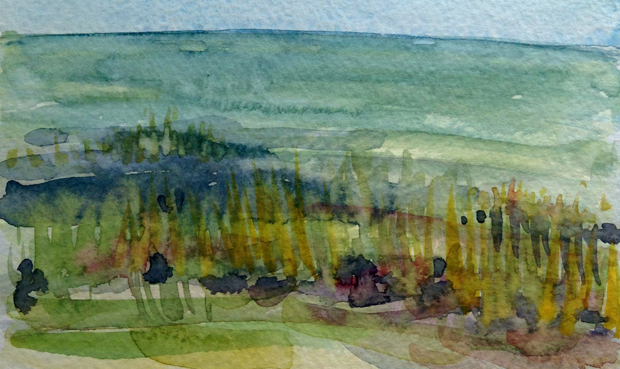A feature of the time we live in is the dominance of an overly rational, materialistic view of things, to the exclusion — or at least debasement and suppression — of the non-rational. The Greeks wrestled with this dual nature of reality, the conflict between mythos and logos, but they did not make the mistake of elevating one over the other in an artificial hierarchy. They understood our experiences to be a dance between visible reality and hidden realms of mystery and transcendence.
“When people spoke of the divine, they were usually talking about an aspect of the mundane. The very existence of the gods was inseparable from that of a storm, a sea, a river, or from those powerful human emotions – love, rage, or sexual passion – that seemed momentarily to lift men and women onto a different plane of existence, so that they saw the world with new eyes.” ~ Karen Armstrong, from “A Short History of Myth”
Since myth is so marginalized today, we are lucky still to have poetry, as a place where mythos and logos can co-exist, a place where important questions are raised, and no answers given.
When I encounter a poem like Tony Hoagland’s “Adam and Eve,” I think of this dance of opposites. He manages to capture the enormity of the gulf of understanding between men and woman. I can go through weeks and years assuming, because we live in close proximity and have daily interactions, that I know my husband pretty well. A poem like this shatters that delusion. The word, “opposite,” is wholly inadequate to express the condition that exists between men and woman.
And yet, Hoagland also reveals how we are the same: we have these animal bodies, and struggle to behave in “civilized” ways. He must have had to summon a great deal of courage in order to speak so honestly. To throw off layers of pretense, guile, manners, culture. To stand naked, using naked words. Going all the way, saying things we never say.
This poem is not a confession of so-called “base instincts,” but an acknowledgement, an ownership of wildness. If we aren’t aware of our wildness, if we don’t befriend it, we will do violent things to each other. Rejecting conformity and political correctness, the poet uses a most potent tool — words, logos — to explore the subject. And what is more civilized than words? Logos and mythos are in a blind dance in this poem:
“Until we tell the truth, there can be no tenderness.”
The poet raises questions about who we are, and who we think we are, questions that reveal these dances — between men and women, and within each of us. Our primitive, animal instincts, like desire, that tend to be at odds, if not war, with our civilized — and civilizing — stories.
I love his choice of title, “Adam and Eve,” serving notice that this is an archetypal story, a story of origins, and of first conditions that are just as present now as in the mythic past. It ripples echoes through modern culture that we deny at our peril.
The Garden of Eden story is freighted with nostalgia for an imagined state of equality, of balance. Without the burden of civilization, Adam and Eve could inhabit their animal bodies with ease and an utter lack of self-consciousness. What happens if we step aside from seeing that as a binary condition? What if we can be both wild and civilized? To do this, we will need to throw off the strictures of old stories.
“As long as there is desire, we will not be safe.”
Lines like this tell me that this poem is about so much more than a man and a woman in bed, struggling in the heat of passion to retain a bit of themselves. It is, as only a poem can be, about everything.
Mythology was designed to help us cope with the problems of life. It helped people to find their place in the world and their true orientation. Lacking a robust mythology, we can at least enter the doorway of poetry and discover a magical land of symbol and myth, inviting us into a more nuanced, imaginative, and honest view of ourselves and our world.

